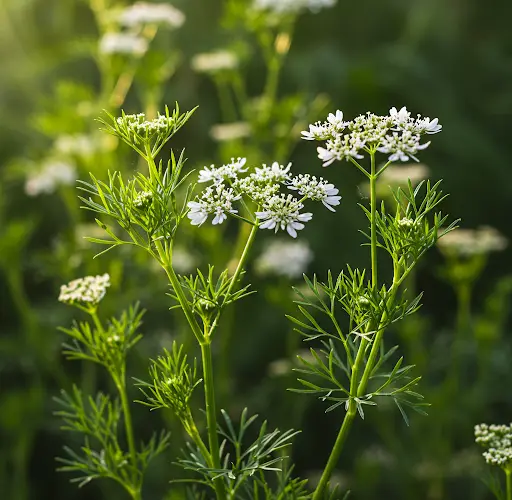How to Grow Coriander in Old Jeans | Growing Coriander from Seeds
Growing coriander (also known as cilantro) in old jeans is a unique, eco-friendly, and space-saving gardening technique. If you love fresh herbs but have limited gardening space, repurposing old jeans as planters is a fun and sustainable way to grow coriander at home. Whether on a balcony, terrace, or backyard, this method allows you to cultivate fresh coriander effortlessly. In this guide, you will learn step-by-step how to grow coriander in repurposed jeans, ensuring a bountiful harvest of fragrant, homegrown herbs.
Why Grow Coriander in Old Jeans?
- Eco-Friendly Gardening – Reuses old jeans instead of throwing them away.
- Space-Saving – Perfect for small gardens, balconies, or vertical gardening.
- Cost-Effective – No need for expensive pots or planters.
- Well-Draining Planter – Fabric allows proper aeration and drainage, preventing root rot.
- Portable & Creative – Move your garden easily and add a decorative touch.
Best Time to Grow Coriander
- Spring and Fall are the best seasons for growing coriander, as it prefers cooler temperatures (15-25°C / 59-77°F).
- It can grow indoors year-round if placed in a well-lit area.
- Avoid extreme heat, as coriander tends to bolt (flower and go to seed) quickly in high temperatures.
How to Grow Coriander in Old Jeans: Step-by-Step Guide
1. Preparing the Old Jeans Planter
- Select an old pair of denim jeans that you no longer use.
- Cut the jeans to the desired height, or use the entire pair by keeping the legs intact.
- Sew the bottom of each pant leg closed or tie it with strong twine to create a sealed planting container.
- Poke small drainage holes at the bottom to allow excess water to escape.
- If using the entire jeans as a vertical planter, attach them to a sturdy frame or fence for support.
2. Choosing the Right Soil Mix
- Coriander thrives in well-draining, nutrient-rich soil.
- Use a mix of garden soil, compost, and sand to provide good aeration.
- Avoid heavy clay soil, as it retains too much water and can cause root rot.
3. Planting Coriander Seeds
- Purchase high-quality coriander seeds from a trusted source.
- For better germination, lightly crush the seeds before planting to help them sprout faster.
- Fill the jeans planter with soil, leaving about 2 inches (5 cm) of space from the top.
- Sow the seeds about ¼ inch (6 mm) deep, scattering them evenly across the surface.
- Lightly cover with soil and water gently.
4. Watering & Care
- Keep the soil consistently moist but not waterlogged.
- Water every 2-3 days or whenever the soil feels dry to the touch.
- Ensure proper drainage by checking that excess water is draining from the holes.
5. Providing the Right Light & Temperature
- Coriander grows best in partial sunlight, receiving 4-6 hours of sunlight per day.
- If growing indoors, place near a south-facing window or use LED grow lights.
- Protect from strong afternoon sun to prevent premature bolting.
6. Fertilizing for Healthy Growth
- Add organic compost or diluted liquid fertilizer every 2-3 weeks.
- Avoid over-fertilizing, as excessive nitrogen can lead to more leaves but less flavor.
7. Harvesting Coriander
- Coriander is ready for harvest in 3-4 weeks after germination.
- Harvest by cutting the outer leaves first, allowing the inner leaves to continue growing.
- If you want coriander seeds (coriander spice), allow the plant to flower and set seeds.
- Collect seeds once they turn brown and dry for replanting or cooking.
Tips for Growing Coriander Successfully
1. Preventing Bolting (Flowering Too Soon)
- High temperatures cause coriander to bolt quickly.
- Keep the plant in a cooler, shaded area during hot weather.
- Regularly harvest leaves to delay flowering.
2. Ensuring Continuous Growth
- Sow new seeds every 2-3 weeks for a continuous supply of fresh coriander.
- Rotate planters or grow in multiple jeans for staggered harvests.
3. Managing Pests & Diseases
- Watch out for aphids, whiteflies, and fungal diseases.
- Use organic neem oil spray or garlic water to keep pests away.
- Ensure proper airflow to prevent fungal infections.
Creative Ideas for Your Jeans Planter Garden
- Vertical Herb Wall – Hang multiple jeans on a wall or fence for a unique herb garden.
- Multi-Pocket Garden – Utilize the pockets of the jeans for planting small herbs like basil and thyme.
- Hanging Planters – Suspend jeans planters from hooks or railings for a rustic garden look.
- Layered Planting – Grow coriander in one leg, and plant other herbs or flowers in the other.
Common Problems & Solutions
1. Seeds Not Germinating
- Make sure seeds are fresh and viable.
- Keep soil moist but not soggy during germination.
- Sow seeds in cooler temperatures (15-25°C / 59-77°F).
2. Leggy or Weak Growth
- Lack of sunlight can cause leggy stems. Move to a brighter location.
- Trim plants regularly to encourage bushy growth.
3. Yellowing Leaves
- Overwatering can lead to yellow, wilting leaves.
- Improve drainage by adding more holes in the jeans planter.
Conclusion
Growing coriander in old jeans is a fun, sustainable, and space-efficient gardening method. Whether you’re a beginner or an experienced gardener, this creative approach allows you to grow fresh coriander at home effortlessly. With proper care, you can enjoy flavorful, homegrown coriander all year round. Try this eco-friendly gardening idea today and transform your old jeans into a thriving herb garden!



